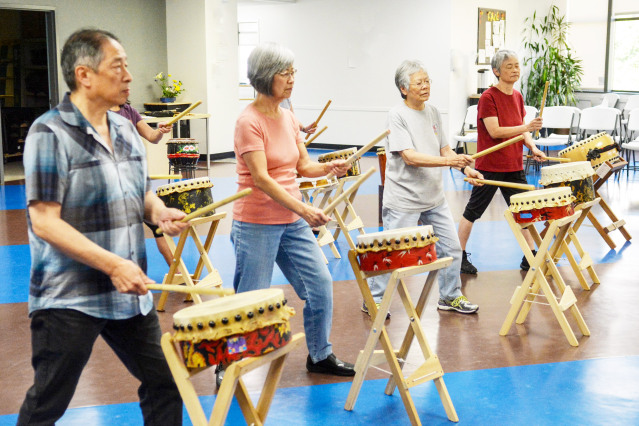
At the Cole Valley Fair in September, 11 members of the Kotobuki Taiko group demonstrated that seniors can drum energetically and with passion. They can also get healthier doing it.
The Kotobuki (longevity) Taiko group was formed nine years ago at The Stonestown Family YMCA Annex, under the leadership of volunteer teacher Carol Ayers, 73, a longtime Taiko drummer.
“I had some surgeries, and couldn’t play up to my best level, but I wanted to continue with Taiko so I went to the Y and offered to start a class,” Ayers said.
Today, Ayers oversees three levels of classes, with 45 students ranging in age from 60 to 85; 40 women and five men. She and another teacher, Fumi Spencer, age 89, teach the seniors and watch them thrive. “Having an infirmity is no barrier to playing – people can sit and play,” Ayers said.
The performance was a chance for the Kotobuki group to share its art form. Andrea Lai Pujolar, 73, loves to bang on the drum. “I enjoy performing because I can beat as hard as I can. I love the energy that it produces in me!” she said.
Rhythm: a basic human function
“Because the response to rhythm is basic to human functioning,” says neurologist Barry Bittman, “it’s no wonder that drummers and observers alike are uplifted. Drumming has been a sacred act since ancient times.”
It was believed that by imitating the sounds of thunder, the spirits of rain would be forced into action. Drumming was used to thank the gods for bountiful crops, and shamans used drumming as a means of reaching a trance-like state.
Today, Taiko drummers perform in festivals and concerts throughout the world. Taiko is a Japanese word meaning a drumming style, a drum group, drum music and the drum itself. The drums range in size from a snare drum (shime) to the most common size, that of a wine barrel. They are made from strips of wood and covered in cow or horse hide.
According to physician and health writer Christiane Northrup, drumming releases endorphins and alpha waves, which are associated with feelings of well-being. Northrup says drumming synchronizes the brain’s left and right hemispheres, strengthening feelings of insight and creativity.
Taiko drumming also elicits feelings of camaraderie and community in the Kotobuki group. “Drumming can be a tremendous social experience,” Bittman said.
It sounds good – and it’s real exercise
“It’s a great physical activity. It keeps me young to keep my body moving,” said Pujolar, who opened the show blowing into a conch shell. She said her breath was strengthened from many years of martial arts. She has a 4th degree Black Belt in karate.
Pujolar has been studying drumming between six to seven years at the Stonestown Family YMCA Annex. But it’s so popular, getting into the group can be difficult . Ayers said the wait list, which has 18 people already, is closed.
In 2014, Ayers’ students nominated her for a Jefferson Award, which is sponsored by the local KPIX television station. The Jefferson Award is given to people in the Bay Area community who make a special contribution. Ayers’ students say they have always viewed her as a “sensei,” which in Japanese is a teacher who is completely dedicated to her students and the art form.
Despite arthritis, Ayers continues to play, teach and oversee classes at the Stonestown YMCA, which offers numerous programs for seniors, most of them for free.
“My journey with Taiko has been a blessing. When you have passion for something, the rewards are great. I want to carry on the tradition of mentoring students and watching them mentor others.”

